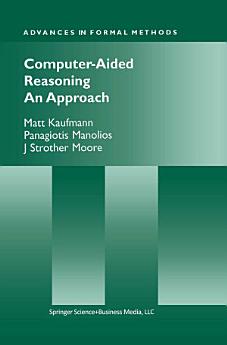Computer-Aided Reasoning: An Approach
Matt Kaufmann · Panagiotis Manolios · J Strother Moore
ડિસે 2012 · Advances in Formal Methods પુસ્તક 3 · Springer Science & Business Media
ઇ-પુસ્તક
270
પેજ
reportરેટિંગ અને રિવ્યૂ ચકાસેલા નથી વધુ જાણો
આ ઇ-પુસ્તક વિશે
Computer-Aided Reasoning: An Approach is a textbook introduction to computer-aided reasoning. It can be used in graduate and upper-division undergraduate courses on software engineering or formal methods. It is also suitable in conjunction with other books in courses on hardware design, discrete mathematics, or theory, especially courses stressing formalism, rigor, or mechanized support. It is also appropriate for courses on artificial intelligence or automated reasoning and as a reference for business and industry.
Current hardware and software systems are often very complex and the trend is towards increased complexity. Many of these systems are of critical importance; therefore making sure that they behave as expected is also of critical importance. By modeling computing systems mathematically, we obtain models that we can prove behave correctly. The complexity of computing systems makes such proofs very long, complicated, and error-prone. To further increase confidence in our reasoning, we can use a computer program to check our proofs and even to automate some of their construction.
In this book we present:
Approximately 140 exercises are distributed throughout the book. Additional material is freely available from the ACL2 home page on the Web, including solutions to the exercises, additional exercises, case studies from the companion book, research papers, and the ACL2 system with detailed documentation.
Current hardware and software systems are often very complex and the trend is towards increased complexity. Many of these systems are of critical importance; therefore making sure that they behave as expected is also of critical importance. By modeling computing systems mathematically, we obtain models that we can prove behave correctly. The complexity of computing systems makes such proofs very long, complicated, and error-prone. To further increase confidence in our reasoning, we can use a computer program to check our proofs and even to automate some of their construction.
In this book we present:
- A practical functional programming language closely related to Common Lisp which is used to define functions (which can model computing systems) and to make assertions about defined functions;
- A formal logic in which defined functions correspond to axioms; the logic is first-order, includes induction, and allows us to prove theorems about the functions;
- The computer-aided reasoning system ACL2, which includes the programming language, the logic, and mechanical support for the proof process.
Approximately 140 exercises are distributed throughout the book. Additional material is freely available from the ACL2 home page on the Web, including solutions to the exercises, additional exercises, case studies from the companion book, research papers, and the ACL2 system with detailed documentation.
આ ઇ-પુસ્તકને રેટિંગ આપો
તમે શું વિચારો છો અમને જણાવો.
માહિતી વાંચવી
સ્માર્ટફોન અને ટૅબ્લેટ
Android અને iPad/iPhone માટે Google Play Books ઍપ ઇન્સ્ટૉલ કરો. તે તમારા એકાઉન્ટ સાથે ઑટોમૅટિક રીતે સિંક થાય છે અને તમને જ્યાં પણ હો ત્યાં તમને ઑનલાઇન અથવા ઑફલાઇન વાંચવાની મંજૂરી આપે છે.
લૅપટૉપ અને કમ્પ્યુટર
Google Play પર ખરીદેલ ઑડિઓબુકને તમે તમારા કમ્પ્યુટરના વેબ બ્રાઉઝરનો ઉપયોગ કરીને સાંભળી શકો છો.
eReaders અને અન્ય ડિવાઇસ
Kobo ઇ-રીડર જેવા ઇ-ઇંક ડિવાઇસ પર વાંચવા માટે, તમારે ફાઇલને ડાઉનલોડ કરીને તમારા ડિવાઇસ પર ટ્રાન્સફર કરવાની જરૂર પડશે. સપોર્ટેડ ઇ-રીડર પર ફાઇલો ટ્રાન્સ્ફર કરવા માટે સહાયતા કેન્દ્રની વિગતવાર સૂચનાઓ અનુસરો.






